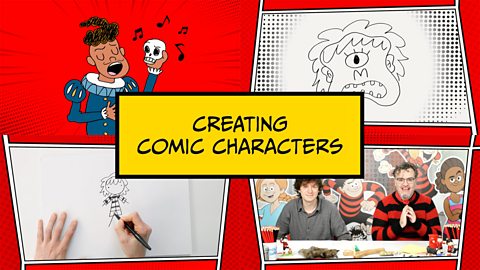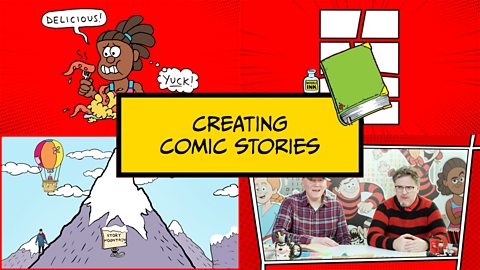(construction noises)
Mike: Hi, my name's Mike, I'm the Director of Mischief at Beano. (fanfare ripples)
This is Rhiannon, Beano's Creative Manager, and she's going to help us create a world for our character.
Rhiannon: Hello. (fanfare ripples)
Mike: When making a comic, you need to think about the world your story takes place in.
We call it the setting.(bell pings)
You might want to work in groups to create your world, so you can bring each of your characters into the same world.
Rhiannon: If you work together, you can think of your characters as a group of friends.
Mike: Rhiannon and I are friends.(exciting music)
A map helps you link your stories, characters, and places.
It helps make them, and you, feel part of a genuine world. The fancy word's a paracosm.
Computer voice: Paracosm: A detailed imaginary world involving humans, animals, and maybe even fantasy creations.
Mike: A map helps you work out who your characters may meet and what they might encounter to get to a certain place in your story.
If our characters walked from their house here to the shops here, what might they encounter along the way? Well, they go past this puddle. So maybe one of them falls into the puddle.
Rhiannon: It doesn't have to be a map of a town. It could be the layout of a boat, or the secret passageways beneath a castle.
Mike: How about making a map about a place you've learned about during a project at school?
Rhiannon: The Stone Age.
Mike: Ancient Egypt.
Rhiannon: Or how about Roman Britain?
Mike: These are all paracosms your characters can explore.
And remember to think about who else lives in the world with your main characters.
Rhiannon: Friends, foes, goodies, baddies.
Mike: These are important when we make up our stories. Grown ups make good baddies.
Rhiannon: Wait, are we the baddies?
Mike: Not in this story. At least for now…
When you have your map and your theme, it's time to add in some daft details.
Rhiannon: At Beano we're inspired by what we see around us in real life.
Mike: Then we have fun by exaggerating it to make it seem larger than life for readers.
Rhiannon: Daft details are everywhere in our backgrounds. A stinky sock.
Mike: A banana skin.
Rhiannon: A squelchy thing.
Mike: Buildings with silly or funny names.
Rhiannon: A confusing sign. Or experiment with unusual proportions.
Mike: Background details will encourage…
Hey, can you make us normal size again? (trombone blares)
Background details will encourage your reader to really engage with your art and story.
With this street, we need to come up with a name.
I can see in the map it's next to some woods, so why don't we call it Wood Lane?
(Rhiannon yawns)
Mike: Well, it's also near the sweet shop, why don't we call it Cotton Candy Crescent?
Rhiannon: That's more like it.
Mike: One of the places in Beanotown is Bash Street School.
So let's think about the sounds that you might hear in a school.
The sound of children running and playing, or the sound of doors opening and closing, or…
Rhiannon: The school bell. (school bell ringing)
Mike: That's a good one.
So when you draw the bell, think about the noise it's making.
If you make the bell bigger, that makes the noise louder.
And to show it's vibrating, we can add short lines around it.
And you can actually write in the sound of the bell, too.
Rhiannon: Those extra Rs really emphasise the shrill sound.
Mike: The technical word for this is an onomatopoeia, when the word is written to sound like the noise.
Rhiannon: Tick tock.
Mike: Yes, exactly. The tick, tock, tick, tock sound of the clock. Well, that's a sound that got turned into a word.
We don't even have to use words that already exist.
We can invent new words.
(object thunks)
That sounded like it made a thunk sound to me.
Do it again.
(object thunks)
That's perfect.
So now you have all the ingredients to make your own comic worlds.
Start by creating a map based on yours and your friends' experiences.
Add some daft details to make your setting more interesting.
And finally, add some sounds to your map, so it sings.
Video summary
Mike ('Director of Mischief') and Rhiannon (Creative Manager) from Beano construct a world for their comic characters.
They talk about creating a comic book setting, or paracosm, for the characters to live in.
They encourage pupils to create a map and name streets, shops and schools, with a suggestion of using real life as inspiration for the map, then exaggerating details in order to create a comic world.
Mike and Rhiannon explore how to use onomatopoeia to describe familiar sounds before adding word soundscapes to their maps.
This short film is from the BBC Teach collection Beano - How to create a comic.
Teacher Notes
Task: Create a Map
In this task, pupils explore the meaning of paracosm before creating a map to show the setting of their story.
- Split the pupils into groups of 3 and 4. They could introduce their characters and get to know their groups’ characters in order to begin to think about the kind of world they might create.
- Introduce the word paracosm and share definition: a detailed imaginary world, involving humans, animals and maybe even fantasy creations. Can pupils think of any paracosms?
- What do we mean by a map? What would we expect to see on a map? Link this discussion to the pupils geography learning (KS1 might discuss a map of their local area for example, whereas Upper Key Stage 2 might think about grid references and symbols).
- Explain that it doesn’t have to be a map of a specific area, but any location. Encourage pupils to think about historical settings they may have studied (e.g. Stone Age, Ancient Egypt, Roman Britain). Explain that these could all be paracosms for your comic.
- Pupils work together in groups to create a map for their paracosm, using their characters and previous learning as inspiration. Explain that pupils need to include the houses that each of the characters live in, a school if appropriate, some shops maybe and other people’s houses/places of work.
Ideas for differentiation:
- Pupils may need a partially completed map to add details to. Encourage older pupils to add as much detail as possible, perhaps including symbols and a grid in order to develop links to the Geography curriculum.
Task: Add Daft Details
Explore the ‘daft details’ discussed in the video. Can pupils come up with any of their own?
- Encourage pupils to think about what they see on their way to and from school, then model how to exaggerate these to create comic-style images.
- Allow pupils time to practise sketching details in their sketchbooks before adding their own ‘daft details’ to their maps.
- Next, pupils add detail to their maps by naming places, roads and landmarks.Focus on the example in the video: Wood Lane. Why is this not the best choice for a comic? Why is cotton candy crescent better? Link back to alliteration as discussed in episode 1.
Task: Soundscape
In this task, pupils add sound to their maps.
- Ask pupils to close their eyes. What sounds can you hear? Create a mind map as a class. How could we recreate these sounds in our classroom?
- Link back to onomatopoeia as discussed in episode 1. Ask pupils to make up their own onomatopoeias for the sounds around them.
- Next, ask pupils to add a soundscape to their map by drawing in details that make noises and then drawing the noises themselves. If there is a pond, for example, draw in the sounds of the water SPLOSHing.
Click here for downloadable version of teacher notes. (PDF, 728KB)
This series is suitable for teaching English and Art and Design/Expressive Arts at Key Stage 2, 2nd Level, and Progression steps 2 and 3 across the UK.
Creating comic characters. video
How to draw, name and create personalities for comic book characters.

Creating comic stories. video
How to create a comic book story using a three-act story mountain structure.
